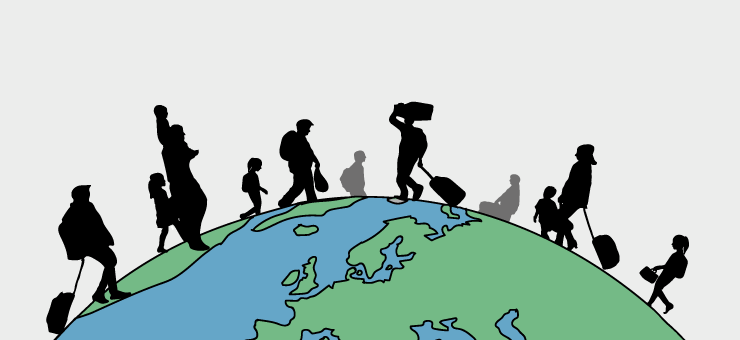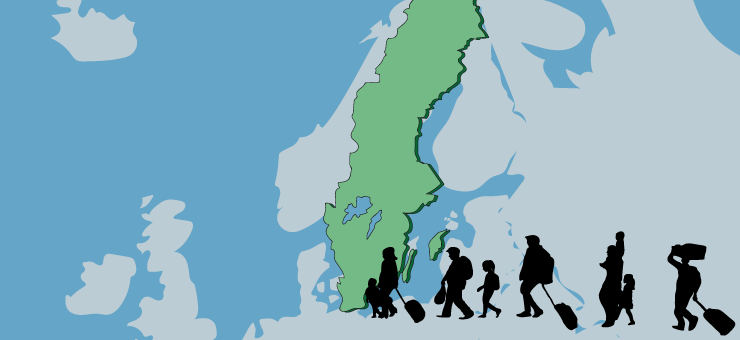Immigrating to Sweden
Last updated: 25/1-2024
This text is about immigrating to Sweden. It describes the history of immigration to Sweden and how it has influenced the country.

It also describes different types of immigration, such as labour immigration and asylum immigration.
You will learn more about the laws and regulations that affect you as a new arrival in Sweden, including information about work permits, residence permits and Swedish citizenship.
Everyone is entitled to seek asylum and to receive protection from persecution. There are many different reasons for seeking asylum, and the type of protection that people need varies.
Sweden is a signatory of the UN’s Refugee Convention. This means that every person seeking asylum here must have their application considered in the same way. Applicants who get asylum will receive a residence permit in Sweden and protection against being deported to their home country.
The number of people in the world who are forced to leave their homes is increasing. In 2020, the number was more than 80 million. That is one per cent of the entire world’s population.
A brief history of immigration to Sweden
During the second half of the 19th century, many families in Sweden were poor. Many were farmers, and winters could be long and cold. It was hard to get enough food. During this period, around 1.5 million Swedes left Sweden. Many of them dreamt of a better life in the United States and travelled across the Atlantic by steamer. At that time, more people emigrated from Sweden than immigrated to Sweden, so the country had what is known as a migration deficit.
Today, there are many people who cross the Mediterranean by boat with dreams of a better life in Europe, including in Sweden. There are more people immigrating to Sweden than emigrating from it, so the country has a migration surplus.
Immigration to Sweden has varied over the years. Sometimes many people arrived over quite a brief period. Many of them arrived because they were forced to flee their native countries. Others came to Sweden to work.
During the second world war (1939–1945), many people arrived who were fleeing Nordic, Baltic and east European countries. In the 1950s and 1960s, Swedish companies needed labour, and many people moved to Sweden to work. Many arrived from Germany, Greece, Yugoslavia, Turkey and the Nordic countries. This immigration contributed to Sweden's booming economy during the period.

Did you know that Sweden had a migration deficit in the past? What are your thoughts on that?
What do you think Sweden did to encourage people to come here to work?
From labour immigration to asylum seekers
In the 1970s, Sweden's economy was not doing so well, and there were not as many job opportunities. As a result, fewer people immigrated to Sweden for work. But many people arrived because of conflicts in their own countries, including from Chile and Iran. They sought asylum in Sweden. There were also many people who moved to Sweden in order to live with other family members who were already here.
In 1975, the Swedish Riksdag adopted new policy guidelines. These new guidelines made it easier for immigrants to maintain their language and culture. Immigrants became entitled to an interpreter when they were in contact with Swedish government agencies, and children at school became entitled to language lessons in their native language. Immigration has brought diversity and contributed to the development of Swedish society and culture.
There were wars and unrest in many parts of the world during the 1980s and 1990s. Many of those seeking asylum in Sweden came from Iran, Iraq, Lebanon, Syria, Turkey, Somalia and what was then still Yugoslavia.
Today, there are 10.3 million people living in Sweden, 2.6 million of whom were born abroad or have at least one parent who was born abroad. This means that 25 per cent of the Swedish population have a foreign background.
Increased movement and stricter controls
The rules for immigrating to Sweden have become stricter since the end of the 1980s. Border controls have become more thorough, and a person now has to have ID documents in order to be allowed in to Sweden.
Why have the rules become stricter, do you think?
Sweden is a member of the European Union (EU). This means that the EU member states decide together about certain things to do with migration.
In the 1990s, the EU decided, for example, that people who wanted to seek asylum in an EU member state had to do so in the first EU member state they arrived in. This rule is known as the Dublin Regulation.
Are you familiar with the Dublin Regulation?
What else do you know about it?
What might the consequences of these rules be for people fleeing to the EU?
In the 2000s, the rules for immigrating to Sweden for work were changed. This was because the EU had agreed that it should become easier to move between EU member states. It was also because Sweden had decided that it should become easier for Swedish companies to hire people from countries outside of the EU.
In 2016, a new temporary law was passed which meant that many people were granted temporary residence permits instead of permanent ones.
What might it mean for a person if they get a temporary residence permit?
What parts of their life will be affected?
Laws and regulations
In Sweden, there is a law called the Aliens Act (Utlänningslagen). It includes rules about asylum, residence permits, work permits and family reunification.
Asylum and residence permits
In some countries, you are not free to hold any opinion you like. You can end up in prison or even be killed for having a certain political opinion. You can also be imprisoned or killed if you believe in a certain religion, for example, or have a certain sexual orientation. If you are living under this kind of threat, you are entitled to seek refuge in another country. Such refuge is known as asylum. People from anywhere in the world can seek asylum and be granted a residence permit in Sweden.
There are also other reasons you can be granted a residence permit. These include an ongoing war in the country where you live, reunification with family members already in Sweden, and studies or work in Sweden.
If your asylum application is approved, this means that you have been granted a residence permit.
- A temporary residence permit (tillfälligt uppehållstillstånd, TUT) means that you can remain in Sweden for a specified period of time.
- A permanent residence permit (permanent uppehållstillstånd, PUT) means that you can live and work in Sweden indefinitely.
People from all over the world seek asylum in Sweden. There were many who applied for asylum in the 2010s, and many of them were also granted residence permits. Between 2010 and 2019, residence permits were granted to between 95,000 and 150,000 people each year. Of these residence permits, between 12,000 and 72,000 each year were granted on asylum grounds.
Why do you think people seek refuge in Sweden?
Work permits
In order for you as a foreign citizen to have the right to work in Sweden, you need a work permit. You apply for a work permit from the Migration Agency.
If your asylum application has been rejected but you have worked during the time you were seeking asylum, you can apply for a work permit instead of a residence permit.
Family reunification
Family reunification means that a family which has been split up can apply for permission to live together in Sweden. The family may be allowed to move to the family member that has been granted a residence permit.
Your family can apply for residence permits in order to move to Sweden if you
- have been granted a permanent residence permit
- have been granted a temporary residence permit as a refugee or a beneficiary of subsidiary protection status, and you appear to have a good chance of being granted a long-term residence permit
- have been granted a temporary residence permit due to an impediment to enforcement, meaning that a decision on rejection or expulsion cannot be carried out, and you appear to have a good chance of being granted a long-term residence permit
- have been granted a temporary residence permit due to particularly distressing circumstances and you appear to have a good chance of being granted a long-term residence permit.
Only your immediate family may move to Sweden to live with you. This means your spouse, partner or cohabitant and your children under the age of 18.
In order for your family to be allowed to move to Sweden you need to show the Migration Agency that you earn enough money to support yourself and your family. This is known as a maintenance requirement. You also have to have a home that is adequate for your entire family.
It’s a human right to live with one’s family, and yet there are requirements and conditions for being allowed to reunite with one’s family in Sweden. Why do you think that is?
Swedish citizenship
If you want to become a Swedish citizen, you have to submit an application to the Migration Agency. You must have turned 18, have a permanent residence permit and have had a permit to live in Sweden for a specified period. If you are under 18 years of age, you can become a Swedish citizen if you apply together with either of your parents. The Migration Agency determines whether you will be granted citizenship.



